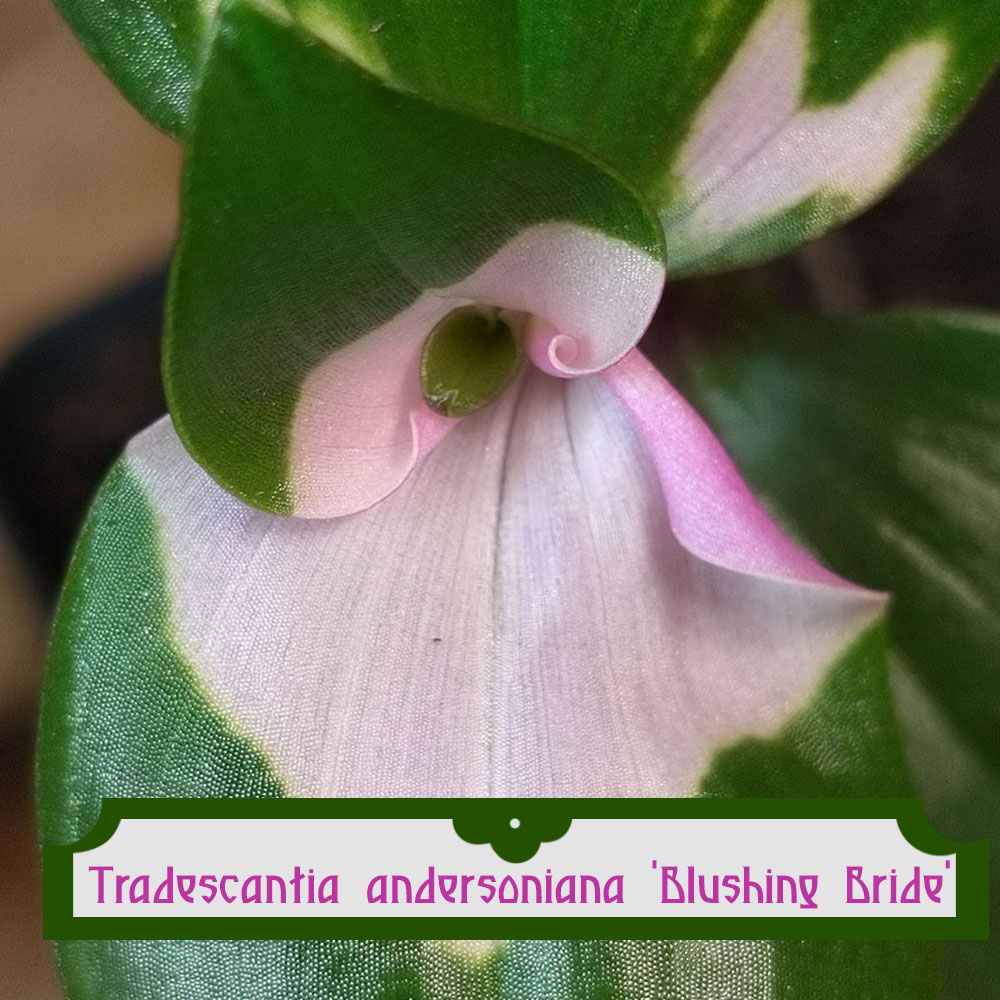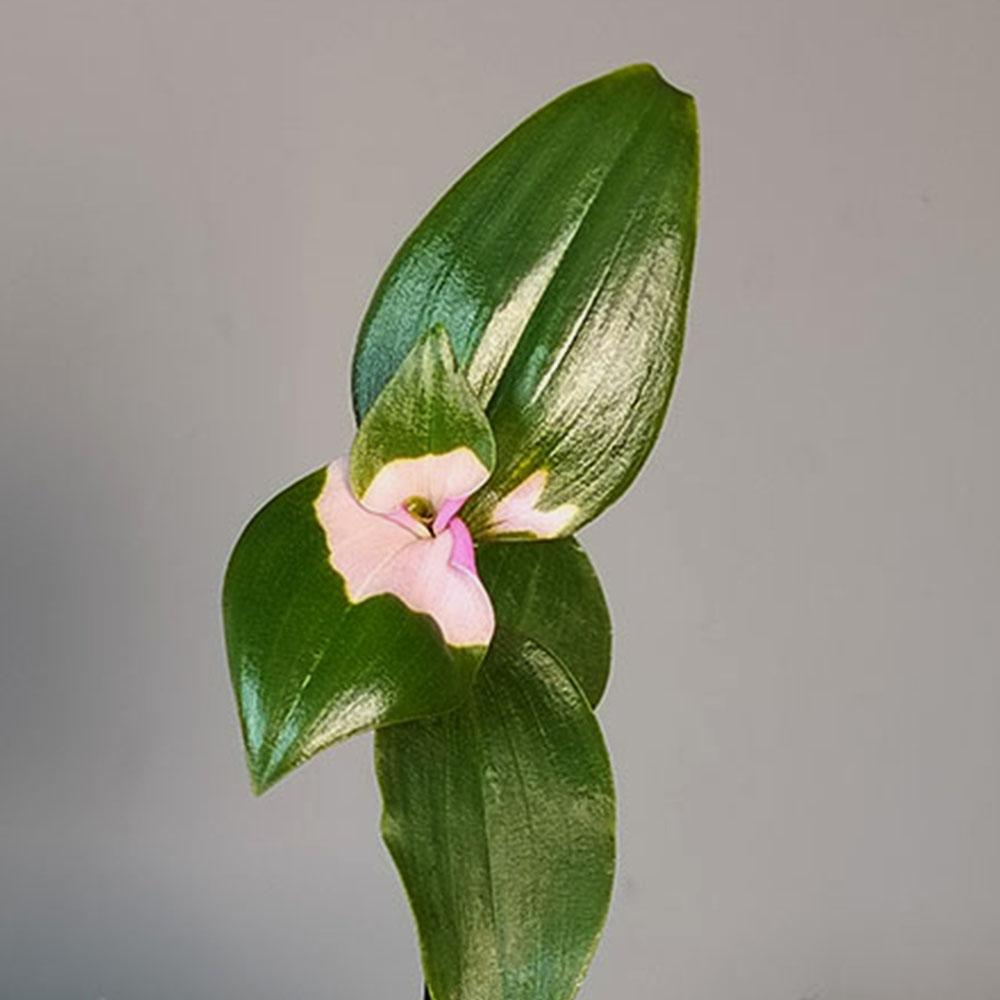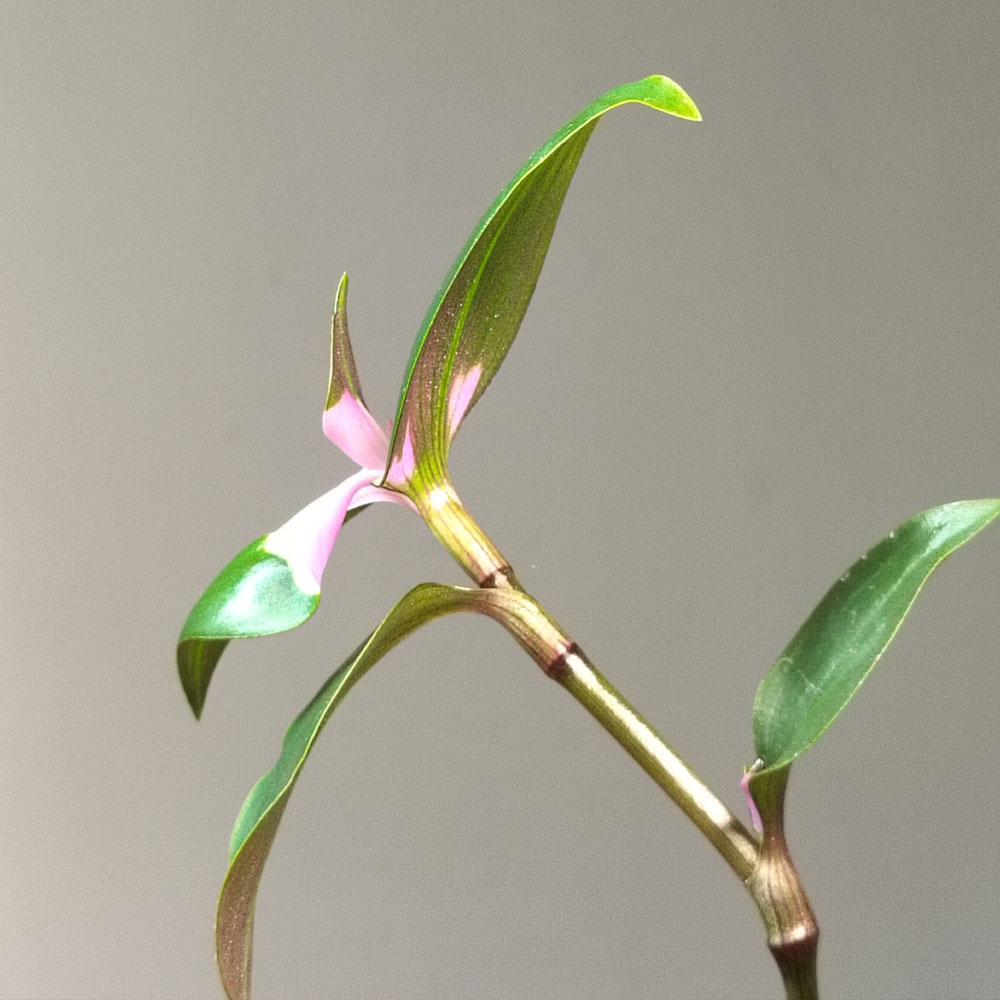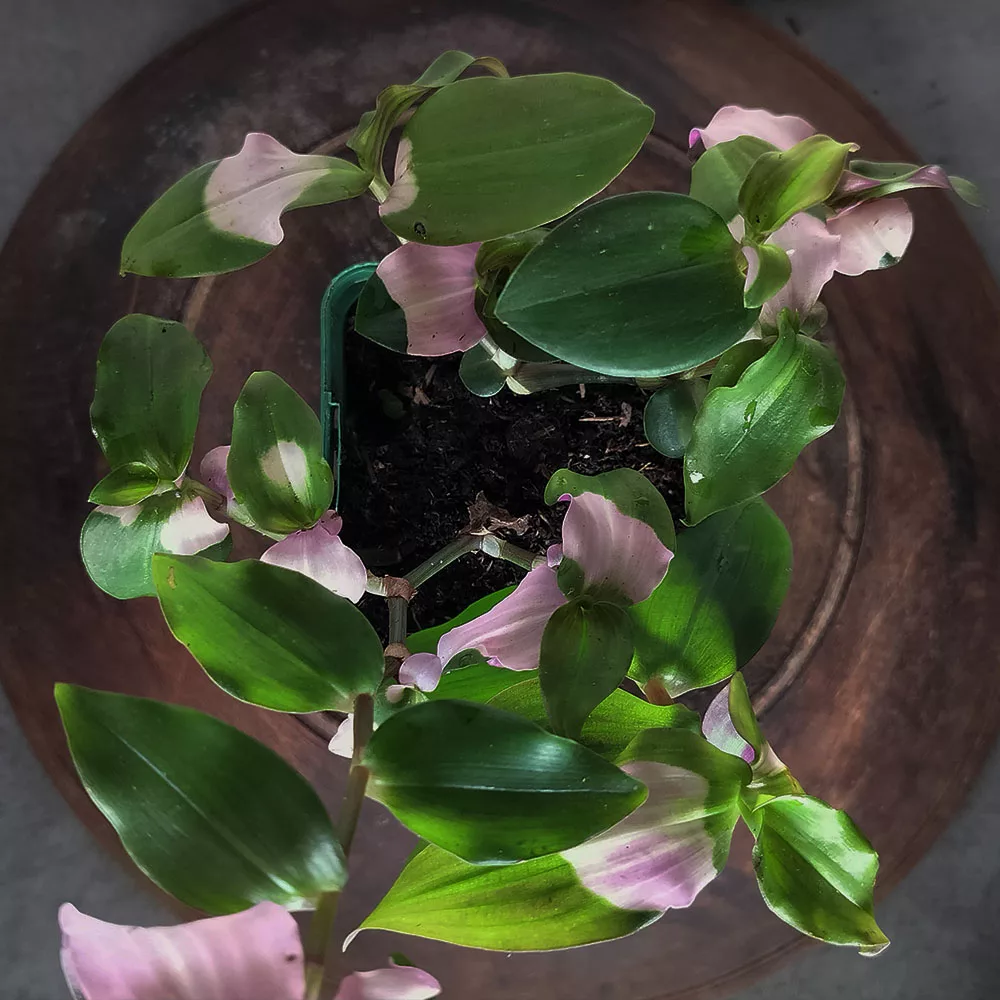No products in the cart.
Tradescantia Blushing Bride
Gorgeous blushes of pink and white that appear in the coldest nights.
Rated 0 out of 5
0 customer reviews
4,00 € – 8,00 €Price range: 4,00 € through 8,00 €
SKU: pda219
Category: Bees and Butterflies, Balcony-Friendly, Better Indoors, Evergreen, Frost Hardy, Ground Cover, Make it Pop, The Stunners

Tradescantia Blushing Bride
4,00 € – 8,00 €Price range: 4,00 € through 8,00 €
Tradescantia Blushing Bride [Tradescantia andersoniana Blushing Bride] is prized for its striking variegated foliage and delicate summer flowers, making it popular for indoor containers, hanging baskets, and mixed garden plantings.
Among their other qualities are their semi- succulent leaves, their drought resistance and their use as bioindicators in many environments.
But this bride has a very particular secret.
Part of the Andersoniana family, she is a particularly cold-hardy Tradescantia. Her root system can whether a frost up to -10°C and return with vigorous growth in the spring.
But be careful now, Tradescantia will still require some protection in the winter – straw, wood chips, pine needles.
For most of the year, Tradescantia Blushing Bride stays green, featuring sturdy, upright stems and a more bushy habit, with large spaces between the leaves.
But once the temperatures begin to drop in the fall, or even on cooler summer nights, the virus that gives this plant its color becomes active, causing gorgeous blushes of pink and white to emerge from fall until spring.
The variegation on the older leaves will shift from pink to white, creating an even more interesting bouquet of colors.
👨🌾GARDENING TIPS👨🌾:
-
- ☁️ Prefers bright indirect light as direct sun can scorch young leaves or fade variegation.
- If the temperatures get too high, Tradescantia Blushing Bride may shed all her leaves (in the nude!) – but fear not. If you cut the stems back, the whole plant will regenerate with brighter and healthier leaves.
- ✂️ Regular trimming maintains compact growth and encourages branching.
- Divide the bunch every 2 years as the growth is very vigorous and dense
- Easily propagated from cuttings year-round; rooting in water is highly effective > check out our step by step article on How to do Tradescantia cuttings. (this one is perfect for beginners)
- Tradescantia Blushing Bride works beautifully in mixed containers, as groundcover in rockeries, or cascading from raised planters – mix with Heuchera Prince or Achillea Terracotta for cute indoor arrangements
- 🏠 Indoors – the foliage will remain the same throughout the winter season – and you may even get some winter blooming!
- 🌲 Outdoors – this variety is very frost hardy – watch her shift colors and remind you to bring in the other Tradescantias that you have on your porch!
Learn more about the Tradescantia family:
The Tales & The Botany: Tradescantia Blushing Bride
Tradescantia, commonly called spiderwort, is a genus in the Commelinaceae family, comprising around 75–90 species of perennial herbs.
Native to the Americas, especially Central and South America, these plants are prized for their vivid foliage and delicate, three-petaled flowers, making them favorites for borders, rockeries, and indoor displays.
The genus was named by John Tradescant the Elder, a 17th-century English botanist and gardener who introduced many North American plants to Europe.
In fact, Tradescantia was one of the first North American plants introduced to European gardens in the 17th century, and some cultivars are now so widespread they are considered naturalized in many temperate regions worldwide.
🌸Floral Morphology: Tradescantia Blushing Bride
Tradescantia Blushing Bride flowers are small, actinomorphic, and trimerous, with three light pink petals.
Flowers are borne in clusters (cymes) at the tips of stems and are short-lived, often opening for a single day but produced in succession to provide extended bloom.
Leaves are alternate, simple, and often lanceolate, with a succulent or slightly fleshy texture in some species. Many cultivars have variegated or purple-tinged foliage, adding ornamental value even when the plant is not flowering.
🍃Reproductive Biology
Tradescantia species are hermaphroditic, capable of self-pollination, though insects such as bees and hoverflies are the primary pollinators.
Fruits are capsular, splitting into three sections containing small seeds.
Some species also propagate readily via stem cuttings, which root easily in soil or water, making Tradescantia a favorite for vegetative propagation and indoor plant enthusiasts.
🌍Ecology & Adaptations
Tradescantia pallida var purpurea thrives in temperate to subtropical environments, so in France we’re limited to using them in:
-
- Container and indoor gardening: This is a perfect variety for container/indoor gardening as it trails, making it ideal for hanging baskets.
Key adaptations include:
-
-
Rapid vegetative growth.
-
Easy propagation
-
Moderate drought tolerance
-
Pest resilience
-
Foliage interest
-
Other Names
Baby Bunny Bellies
Origin:
North and South America
| Weight | 0,5 kg |
|---|---|
| Container Size | 9×9 cm, 1L |
| Flowering | June, July, August |
| Soil | Well-Draining |
| Exposure | Indirect Sun |
| Frost Tolerance | -5°C to -10°C |
| Size | 0.35m H x 0.4m W |
Reviews
0
Rated 0 out of 5
0 customer reviews
5
0
4
0
3
0
2
0
1
0
Only logged in customers who have purchased this product may leave a review.
Related Products
Erigeron kavinskianus
A daisy-like carpet of flowers
A daisy-like carpet of flowers
Rated 0 out of 5
Melissa officinalis
A perennial plant in the mint family that is adored by bees, royal families and tea drinkers.
A perennial plant in the mint family that is adored by bees, royal families and tea drinkers.
Rated 0 out of 5
Glechoma hederacea
A sweet smelling ground cover, producing little blue flowers all summer long.
A sweet smelling ground cover, producing little blue flowers all summer long.
Rated 0 out of 5
Hieracium maculatum Leopard
A native perennial with blue-green leaves and a tall yellow flower
A native perennial with blue-green leaves and a tall yellow flower
Rated 0 out of 5
Sedum album
A low, multi-color ground cover.
A low, multi-color ground cover.
Rated 0 out of 5
Hellebore argutifolius
Winter flowering perennial with marbled blue-green leaves
Winter flowering perennial with marbled blue-green leaves
Rated 0 out of 5
Stachys byzantina
Silky white-grey leaves and tall striking flowers
Silky white-grey leaves and tall striking flowers
Rated 0 out of 5
Potentilla anserina
A distinctly silvery, silky and lacy perennial.
A distinctly silvery, silky and lacy perennial.
Rated 0 out of 5
Mentha x piperita ‘Chartreuse’
A spicy mint, known for its use in the production of liqueurs and herbal teas.
A spicy mint, known for its use in the production of liqueurs and herbal teas.
Rated 0 out of 5
Euphorbia cyparissias Clarice Howard
A Euphorbia that resembles a soft little cyprus tree
A Euphorbia that resembles a soft little cyprus tree
Rated 0 out of 5
Echinacea purpurea
A perennial with purple flowers all summer long
A perennial with purple flowers all summer long
Rated 0 out of 5
Delosperma cooperi
A dwarf perennial known for its vermillion colored flowers
A dwarf perennial known for its vermillion colored flowers
Rated 0 out of 5
Kalanchoe daigremontiana
A toothy succulent from Madagascar, known as the Mother of Thousands.
A toothy succulent from Madagascar, known as the Mother of Thousands.
Rated 0 out of 5
Trachelospermum asiaticum ‘Ogon Nishiki’
Jasmine with colorful foliage and lovely white flowers in summer
Jasmine with colorful foliage and lovely white flowers in summer
Rated 0 out of 5
Vinca minor
Looping elegance and ability to form a low flowering ground cover
Looping elegance and ability to form a low flowering ground cover
Rated 0 out of 5
Euphorbia myrsinites
Known for its draping form of silver-gray foliage and radiant blooms.
Known for its draping form of silver-gray foliage and radiant blooms.
Rated 0 out of 5
Cerastium tomentosum var. columnae
A grey-green spreading ground cover from the mountains.
A grey-green spreading ground cover from the mountains.
Rated 0 out of 5
Artemisia Valerie Finnis
A semi-evergreen, aromatic variation on the theme of Artemisia.
A semi-evergreen, aromatic variation on the theme of Artemisia.
Rated 0 out of 5
recent view product
Carex morrowii var. temnolepsis
A perennial grass loved for high arching, evergreen leaves
A perennial grass loved for high arching, evergreen leaves
Rated 0 out of 5
Nepeta x faassenii Six Hill’s Giant
Catnip is known for its grey-green, aromatic foliage and masses of lavender blue flowers.
Catnip is known for its grey-green, aromatic foliage and masses of lavender blue flowers.
Rated 0 out of 5
Cistus (x) pulverulentus – Ciste pulvérulent
Dark green velvety bush covered in bright pink flowers
Dark green velvety bush covered in bright pink flowers
Rated 0 out of 5
Erigeron glaucus
A flowering plant with large white-pink flowers
A flowering plant with large white-pink flowers
Rated 0 out of 5
Trachelospermum asiaticum ‘Ogon Nishiki’
Jasmine with colorful foliage and lovely white flowers in summer
Jasmine with colorful foliage and lovely white flowers in summer
Rated 0 out of 5

















































There are no reviews yet.